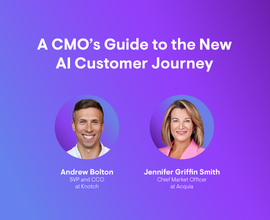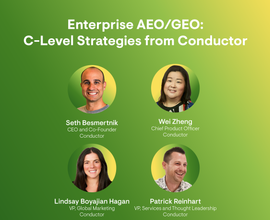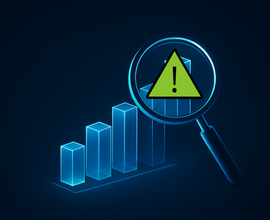What is Organic Marketing?
Organic Marketing attracts customers and promotes content without paid. Include SEO best practices into your strategy to increase traffic and drive revenue.
If you have ever wondered about the best approach to increase your brand or business’s online presence, you have probably spent some time thinking about organic marketing. And it’s for a good reason. Organic marketing delivers over half of all website traffic, provides consistently high click-through rates and delivers dependable long-term ROI, making it something definitely worth thinking about.
Although organic marketing is often understood as just search optimization, keywords and meta tags, there is more to it. A quality organic marketing strategy requires a comprehensive understanding and approach to digital marketing that spans many strategies and applications. In other words, good organic marketing is all about agility – it’s about being able to address dynamic user needs with relevant and engaging content on a variety of platforms while monitoring your impact and implementing technical changes that maximize results. In this article, you will learn not just what organic marketing is and how it differs from (and works in concert with) paid advertising, but also how to be agile with your digital marketing strategy to achieve the most beneficial impact on traffic, conversionConversion
Conversions are processes in online marketing that lead to a defined conclusion.
Learn more and revenue.
What is Organic Marketing?
The definition of organic marketing starts broad but becomes more specific the more you learn. In its most fundamental form, Organic Marketing is a type of digital marketing that attracts customers and promotes content without relying on paid avenues like ads or boosted posts. You may have also heard it called inbound marketing, content marketingContent Marketing
Content marketing is a marketing discipline with the goal of increasing awareness and scope for products and brands in the desired target group with content published on the web and offline.
Learn more, ground up marketing, or SEO. As all of these names imply, the principle force relies on growing naturally by providing quality content that invites users in. The concept is based on a simple truth: people want trustworthy and valuable information. Understanding organic marketing helps you create content that people need, and implementing it puts your content in front of those who need it most.
Constructive organic marketing is about having foresight in identifying customer needs and understanding what motivates them to take action.
At the end of the day, the basic goal of any digital marketing strategy is to drive website traffic and generate and convert leads. Because organic marketing does this by creating authentic customer relationships built on trust, the resulting impact is highly effective. To understand how it works, remember that constructive organic marketing is about having foresight in identifying customer needs and understanding what motivates them to take action. It’s not just about Search EngineSearch Engine
A search engine is a website through which users can search internet content.
Learn more Optimization (SEO), but involves applying a strategic approach at each level of the creation process. In addition to SEO, you should consider your content, development and web teams, and most importantly, how they can work together.
- SEO: The object of SEO is to help the search algorithm understand your content. By using well-researched keywords and applying accurate meta tags, you are essentially labeling your content and web pages. The search algorithm wants to provide users with the most relevant and exact results, and it uses those keywords and meta tags to determine what it will display in response to a certain query. Good SEO practices will help you rank higher in the SERP, ensuring your content is shown to people who are genuinely interested in it, which will in turn, increase your CTR.
- Content: Content is front and center of every organic marketing program, from blog posts and infographics to videos and presentations. This is where the value and trust is built, so you must consider your target audience and create content that is highly relevant and beneficial to them. Creating content that has a long shelf life and is pertinent to your audience’s stage of the buyer’s journey will help build brand awareness. This awareness will lead to increased loyalty, trust and ultimately, buying behavior.
- Web Development: This is the coding and architecture that brings your organic marketing strategy to life. The technical aspects of your website, email and landing pages impact your ability to convert prospects into customers and handle increased web traffic. When your website is not optimized for search engines or doesn’t work with your marketing automation platform, you’re losing out on potential customers and sales. You must consider a scalable solution that can grow with the demand of your business.
By having these teams work together, you can make sure your messages are always aligned. This will help you pinpoint, test and improve marketing effectiveness. As a result, you’ll gain more website visitors, leads and customers.
Remember, the definition of organic marketing encompasses everything that is done without paid help, so it includes things like social media, natural link building, mobile optimization, and email lists (more on all of these below).
Organic vs. Paid Marketing
To fully recognize the benefits organic marketing offers, it’s helpful to look at it in relation to paid marketing.
Paid search results appear at the top of the SERP and are often labeled as “ad” or “suggested” in their listing. But paid advertising can also include things like page banners, boosted posts and video ads. Usually, it’s considered paid because you Pay Per Click (PPC), meaning that each time a user clicks the ad, the business running the ad pays. Although you are essentially paying to be seen when using paid ads, where and how the ads are displayed will still use the same algorithmic process to determine relevancy. Mainly, this is about showing the ad to a demographic of people that, based on cookiesCookies
Cookies are small text files that are saved on a user’s local computer when browsing and sent back to the server when the user visits the same sites again.
Learn more, are presumed to be an interested audience.
Because paid ads will begin being displayed as soon as you begin paying, they are effective at generating quick results. But, as the data shows, being quick is not synonymous with being more effective. Plus, the quick-acting momentum falls off as fast as it begins, and once you stop paying, the results stop as well. In truth, PPC is a volatile approach, and what it can provide in terms of immediacy, it lacks in longevity and accuracy. Promoted content may not address the specific needs of a user and can often be misdirected to a poorly targeted audience. Not only does that contribute to a low CTR, but for users who do click-through, when the website content doesn’t directly address their search, brand distrust ensues. This creates a sense of sale-driven inauthenticity in paid ads among users, who feel they are being pushed into clicking something instead of genuinely helped.
On the other hand, organic marketing yields slower results but is long-term and fosters brand trust and loyalty. For example, after the initial investment of creating and optimizing content, your website will continue to rank and drive traffic. Additionally, because organic marketing is rooted in the value of content, once people click-through to your site, their expectations are likely met, resulting in conversion and sharing.
The most effective digital marketing strategy will combine some form of paid marketing with organic; the paid offering a fast return while your organic efforts take time to mature.
At the same time, it’s widely believed that the most effective digital marketing strategy will combine some form of paid marketing with organic; the paid offering a fast return while your organic efforts take time to mature. This is known as a holistic marketing strategy, and it recognizes that the best results often incorporate a variety of marketing channels to address your brand’s needs as a whole. Here are a few reasons why:
- The metrics that track PPC are sophisticated and accurate, providing valuable data about your users and how they interact with your content that can be implemented into your organic strategy.
- Balancing the cost-effectiveness of organic with the big initial investment of paid means saving money upfront without sacrificing immediate reach.
- When you appear simultaneously in the paid and organic search results, you increase your visibility and attract even more potential for clicks.
- When unforeseen changes occur, like Google’s recent announcement to phase out third-party cookies, ROIs for paid advertising can quickly drop off. If you have a solid organic foundation, you will continue to grow.
While organic marketing is the most effective way to reach new customers and should be your priority, starting out with a combination of paid and organic is a useful approach. Learn more about combining your marketing efforts by taking our Academy Course on paid and organic synergy.
How to Develop an Organic Marketing Strategy
As you can see, organic marketing is grounded in understanding and utilizing a variety of important elements, and developing a good organic strategy is all about incorporating and connecting those assets. Whether you are part of a large team or working independently, a successful content strategy must be rooted in SEO. Use these four tips to develop a comprehensive organic marketing strategy.
1. Create Net-New and Evergreen Content
Understand the voice of the customer in order to develop content that addresses their specific needs, pain points and desires. As you will see time and time again, this requires some pre-creation research. In this case, that means investigating keywords to determine what sort of content your audience is trying to find. Identifying popularly searched keywords allows you to focus on topics that provide specific value for your target audience. Once you know what your audience is looking for, and you can understand customer demand, you will have a better idea of what kind of organic content needs to be created.
This enables you to make net-new and evergreen content that offers unique and highly relevant information. To reach a diverse audience and address their range of needs, content needs to be fresh, helpful and entertaining. That’s why using keywordKeyword
A keyword is what users write into a search engine when they want to find something specific.
Learn more research is so important – it allows you to directly respond to the types of questions your audience is asking with new and long-lasting content. That can mean identifying gaps in your own content or seeing what your competitors are doing and find what is missing from your field in general. You can also do this by expanding onto new platforms. So if you usually rely on blog posts, try making a video or an infographic. Either way, just make sure it’s distinct, precise and relevant.
2. Optimize Content
Speaking of optimized content, another good organic marketing strategy will use SEO to not only help new content rank but to reinvigorate your existing content. You can update things like title tags and meta descriptions or add backlinks to help drive traffic to poor-performing content and get it back into SERP rankingsRankings
Rankings in SEO refers to a website’s position in the search engine results page.
Learn more.
You should also learn from your high-performing content to help you better understand your audience and apply what you learn to as you go forward. Do this by analyzing your data. Ask yourself questions like: What types of posts have the highest visibility? Which drove the most traffic to my site? Which formats (blog posts, videos, email campaigns, how-to, listicles, etc.) had the highest ROI? These answers will allow you to make consistent adjustments that keep your organic marketing strategy agile and effective.
3. Technical SEO
In the same way that your marketing strategy must incorporate numerous variables, so must your SEO. While the breadth of optimization can be wide, the technical aspects revolve around a few core principles.
- Title Tags: The title tag does exactly what its name implies—it tags the title of your page in its HTML code so it can be displayed in the SERP, seen by users, and is an important feature for ranking algorithms.
- Meta Descriptions: A meta description is another type of HTML tag that describes your web page’s content. While the meta description does not directly affect ranking, it plays a big part in helping a user determine the relevancy of your page to their query and whether or not they want to click through to your site.
- User Experience: Having good UX cannot be overstated and should be as important to you as the rest of your SEO. With the huge number of places people can find information, no one wants to waste their time with a site that is hard to use. Make sure how a user interacts with your content is as good as the content itself with things like adding alt text for images, addressing accessibility needs and ensuring loading speeds. Plus, a strong UX is also one of the most important ranking factors for Google so it’s a critical consideration for organic marketing.
Keeping the technical side of your SEO in tip-top shape on all your platforms will ensure your brand can always be found, no matter what the future of privacy laws or budget allotments have in store. Ensure you are ready for the future by running a Core Web Vitals Report today.
4. Be Holistic
You can also be holistic within the parameters of your organic marketing. Once you get your SEO in place, keep these ideas in mind.
- Email Marketing: Curating a good email list, using CTAs in the emails and providing links in emails can all be highly effective organic ways of reaching your audience.
- Backlinks: Think of your reach as a network or web. The more links (both internal and external) you have, the more chances someone has to find your network and all the content you provide. You can create your own links within your site with cluster content and seek out ways to be featured in other places by contributing guest posts.
- Social Media: Social media’s potential to generate traffic and broaden the user base is beyond proven. Adding good social media practices to your organic strategy allows you to directly interact with consumers and engage in the most current and relevant conversations happening in your field. Social media is about consistency, so consider where your audience is and choose the platform accordingly.
- Mobile Optimization: This falls back into creating value through UX, but it’s so important it’s worth saying twice. Don’t forget, over half of all internet traffic is on mobile devices, so managing the mobile experience is critical.
Get the Expertise of an Enterprise Organic Marketing Platform
Organic marketing is the cornerstone of a digital strategy that continues to engage an audience and grow. The most efficient and effective approach involves employing a close-knit integration between your content, SEO, and web teams. It’s a balance between creativity and technology, and to ensure you are maximizing your collaborative possibilities and operational health, you need the expertise of an enterprise organic marketing platform.
Are you making the most of your organic marketing possibilities? If you aren’t using an organic marketing platform like Conductor, you may be missing key components of your potential to improve traffic, productivity, cross-channel efficiency and online revenue. An enterprise organic marketing platform connects your team, systems and processes in one place to create value and impact, and according to The Forrester Wave, Conductor is the top SEO platform available.
If you are ready to see what a top-rated organic marketing platform can do to increase your organic marketing efforts, request a free live demo and get started today.







